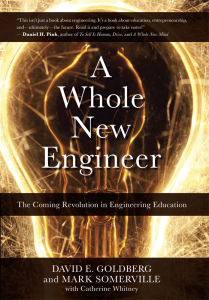Summary
A Whole New Engineer: The Coming Revolution in Engineering Education tells the improbable stories of Franklin W. Olin College of Engineering, a small startup in Needham, MA with aspirations to be a beacon to engineering education everywhere, and the iFoundry incubator at the University of Illinois, an unfunded pilot program with aspirations to change engineering at a large public university that wasn’t particularly interested in changing. That either one survived is story enough, but what they found out together changes the course of education transformation forever.
Table of Contents
Introduction: An Improbable Journey
Chapter 1: Engineering Happiness – The Olin Experience
Chapter 2: The Incubator – Helping a Big Old Dog Learn New Tricks
Chapter 3: The Spirit of Invention – Recapturing the Inspiration of Engineering Education
Chapter 4: The Whole New Engineer – Engaging the 6 Minds
Chapter 5: The Emotional Breakthrough – 5 Pillars of Transformation
Chapter 6: The Whole New Learner – From Carrots and Sticks to Intrinsic Motivation
Chapter 7: The Whole New Professor – From Expert to Coach
Chapter 8: The Whole New Culture – From Classrooms and Curriculum to Culture
Chapter 9: Changing the Way We Change – From Bureaucracy to Change Management
Epilogue: An Invitation to Collaborative Disruption

